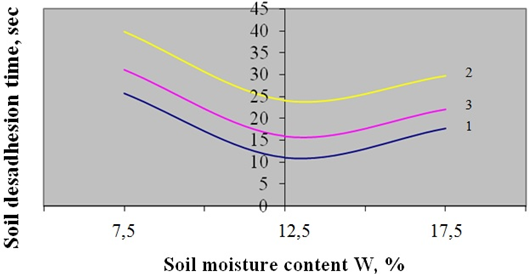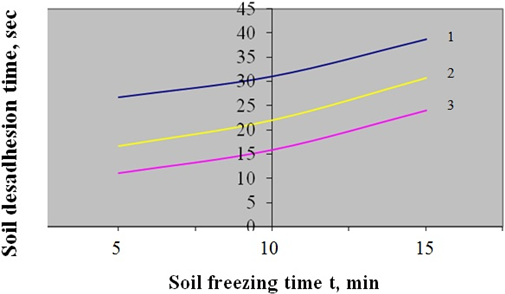APPLICATION OF HIGH-FREQUENCY EFFECTS TO REMOVE GROUND ADHESION ON MACHINES WORKING BODIES
Зеньков С.А.
ORCID: 0000-0002-4948-0223, Кандидат технических наук, доцент, Братский государственный университет
ПРИМЕНЕНИЕ ВЫСОКОЧАСТОТОГО ВОЗДЕЙСТВИЯ ДЛЯ УСТРАНЕНИЕ АДГЕЗИИ ГРУНТА НА РАБОЧИЕ ОРГАНЫ МАШИН
Аннотация
В данной статье рассматривается применение пьезокерамических излучателей для борьбы с адгезией грунтов к рабочим органам машин. Также был выполнен эксперимент, и получены экспериментальные данные. После обработки были получены закономерности и показана графическая интерпретация влияния пьезокерамических излучателей. В дальнейшем были сделаны выводы, что применение пьезокерамических преобразователей более выгодно с точки зрения компактности и равномерности расположения по поверхности рабочего органа чем, к примеру, использование существующих на данный момент средств для обогрева ковша или вибрационного воздействия. Показано, что техническая производительность машин с устройством интенсифицирующего действия для снижения адгезии грунтов при работе на влажных грунтах при отрицательной температуре в 1,2…1,4 раза больше, чем у машин, не оборудованных подобным устройством.
Ключевые слова: пьезокерамика, излучатель, адгезия, машина, грунт.
Zenkov S.A.
ORCID: 0000-0002-4948-0223, PhD in Engineering, Associate professor, Bratsk State University
APPLICATION OF HIGH-FREQUENCY EFFECTS TO REMOVE GROUND ADHESION ON MACHINES WORKING BODIES
Abstract
This article examines the use of piezoceramic emitters for controlling adhesion of soil to the working bodies of earth-moving machines. Also an experiment was performed and the experimental data was obtained. After further processing of patterns a graphical interpretation of the effect of piezoceramic emitters was obtained. Subsequently, it was concluded that the use of piezoceramic emitters is more preferable in terms of compactness and equal spacing on the surface of the working body than, for example, the use of the currently existing means for heating the ladle or vibration exposure. It has been shown that the technical performance of the machines with the intensifying device to reduce adhesion of soils when working on wet ground at a negative temperature is 1.2…1.4 times greater than the machines not equipped with such a device, i.e. there is economic impact of their implementation due to increased productivity.
Keywords: piezoceramic, emitter, adhesives, machines, soil.
Introduction
There are four groups of methods to decrease the soil adhesion to surface of earthmoving machines working units: creating intermediate layer in the interface; methods that contribute to reduce adhesion bonds under the external (intensifying) influence; design-technology methods; combined methods. It was found that the most effective ones are the combined methods based on the advantages of two methods and, in particular, vibrothermal approach [1-3].
This article deals with the application of the high frequency impact, which is considered to belong to combined methods (the combination of high frequency vibration and heating).
The aim of this study was to investigate the influence of vibrothermal piezoceramic emitters (Table 1) on the adhesion process between soil and soil-engaged machine units.
Materials and methods
The experiments were made on a laboratory stand at different environment temperature (-100C, -150C, -200C). The soil used for performing tests was dispersed connected loamy soil with different moisture content X1 (W=7.5%; 12.5%; 17.5%).
Table 1 – Main parameters of the piezoceramic emitters
| Converter type | PP1-0.063/37 |
| Electric power, kW | 0.063 |
| Resonant frequency, kHz | 37±7.5% |
| Amplitude of mechanical oscillations, micron | 1,5 |
| Dimensions, mm | Ш 50х60 |
| Speaker diameter, mm | 50 |
The source soil for the experiment was exposed to additional processing to achieve the stability of the mechanical properties for the entire series of experiments with the soil type.
The essence of the experiment was as following: the sample with specific weight moisture was placed on the excavator bucket simulator set with piezoceramic emitters. Then it was frozen at a certain temperature during the period of time according to the table 2. After that the transmitter was switched on and the time needed for the sample to detach from the simulator was measured.
Multivariate methods were used for experimental studies planning to maximize the useful information obtained with the minimum amount of experiments. This is especially important when the separate processes modelling (e.g. temperature) imply certain difficulties.
Insufficient knowledge of the processes necessitated applying of mathematical apparatus of the theory of experimental design to produce mathematical models of processes. The response function (the parameter optimization) for the impact of the factors determining the behavior of the system being studied was considered to be time after which the soil detached from the simulator. This parameter meets the requirements for parameters optimization: it is universal, it is expressed by one member and quantified, it has statistics presented in efficiency, it can be easily calculated, it is simple and exists for all possible states.
A priori information analysis assumes process description with the following equation:
![]() (1)
(1)
where Y – calculated value of the response function;
Ci – equation ratio;
X1, X2–factors affecting the process.
According to the recommendations and the features of experimental research, in order to obtain the mathematical model (1) for the active experiment, we select item which is the most appropriate for the respective number of factors: symmetric quasi-D-optimal plan for a two-factor model with N = 13 (plans have a "star points" with shoulder a = ±1).
Coding of variables in the experimental and statistical modeling was based on the following formula:
![]() (2)
(2)
where xi is the natural value of the i-th variable; ![]() is the average value of the variable;
is the average value of the variable; ![]() is variation range of i-variable.
is variation range of i-variable.
Return from the coded variables to natural ones comes from (2):
![]()
Table 2 – Levels of factors and variability intervals
| Factors | Levels of factors | Variability intervals | ||
| -1 | 0 | 1 | ||
| X1 – soil moisture content W, % | 7.5 | 12.5 | 17.5 | 5.0 |
| X2 – soil freezing time t, min. | 5 | 10 | 15 | 5.0 |
Experimental studies were randomized to eliminate the influence of systematic errors, i.e. experiments were performed in random order. The levels and variability intervals of factors are based on a priori information analysis. Matrix of experimental studies planning in coded form and the results of the experiment are presented in Table 3.
Table 3 – Matrix of planning and results of the experiment
| Experience № | X1 | X2 | Y, с |
| 1 | - | - | 17 |
| 2 | + | - | 15 |
| 3 | - | + | 30 |
| 4 | + | + | 40 |
| 5 | - | - | 19 |
| 6 | + | - | 17 |
| 7 | - | + | 47 |
| 8 | + | + | 37 |
| 9 | 0 | - | 9 |
| 10 | 0 | + | 30 |
| 11 | - | 0 | 28 |
| 12 | + | 0 | 29 |
| 13 | 0 | 0 | 12 |
Calculating unknown coefficients of the equation was performed using the software complex ModelNR.
Results
The result was obtained in coded form from the regression equation of soil detachment time:
soil moisture content


Fig. 1, 2 show the graphic interpretation of the regression equations received after mathematical processing of experimental results by means of Advanced Grapher software.

Fig.1 - Soil detachment time dependence on the soil moisture content at environment temperature-200 (1); -150 (2); -100 (3)
The graph shows that the detachment of soil sample with moisture content of 7.5% from the surface of the simulator working unit at the end of the 15 minutes freezing period requires longer exposure of the emitter regardless of the ambient temperature. This happens because the soil contains little moisture and the sample not only freezes to the metal, but also adhesion process takes place, requiring more energy to dry up the soil in the contact with the metal. When soil moisture content is 17.5%, it needs less time of emitter exposure, because the more soil moisture content is, the thinner ice layer on the metal unit is as it determined by the strength of the ice, and [1] vibrothermal impact on the frozen soil primarily destructs the ice in the soil. The graph also shows that for soil moisture content of 12.5% the required time of action should be the least, as there is not enough moisture in the soil for strong freezing to the metal and the process of the adhesion does not take place, as the soil moisture freezes faster.

Fig. 2 – Soil detachment time dependence on the soil freezing time at environment temperature-200 (1); -150 (2); -100 (3)
On this graph it can noticed that when the environment temperature is between -100 and -200 (soil sample moisture content of 17.5% corresponds to the natural moisture content for this soil type), freezing time increases and results to increasing the time of the emitter exposure required for detachment of the soil sample from the simulator. This fact is the phenomenon that at subzero temperatures the time of moisture freezing in the soil sample is directly proportional to the environment temperature decrease.
Conclusions
The analysis of the obtained results shows that the usage of piezoceramic emitter to reduce the adhesion between soil and soil-engaged farm machine units at subzero temperatures and 1.2...1.4 time increases [3] the productivity of arm machine comparing to the units not being equipped with such device. It is possible to speak about the appropriateness of piezoceramic emmiters to be used for reducing the adhesion between soil and soil-engaged farm machine units.
Список литературы / References
- Science and Education [Text]: materials of the II international research and practice conference, Vol. I, Munich, December 18th-19th, 2012 / publishing office Vela Verlag Waldkraiburg – Munich – Germany, 2012 – 650 p.
- Зеньков С.А. Методика расчета оборудования с акустическим воздействием для снижения адгезии грунтов к ковшам экскаваторов // Вестник Иркутского государственного технического университета. 2006. № 2-1 (26). С. 67-72.
- Зеньков С.А., Товмасян Э.С. Математическая модель для определения параметров оборудования высокочастотного действия при проектировании ковшей экскаваторов // Современные проблемы теории машин. 2014. № 2. С. 41-44.
Список литературы на английском языке / References in English
- Science and Education [Text] : materials of the II international research and practice conference, Vol. I, Munich, December 18th-19th, 2012 / publishing office Vela Verlag Waldkraiburg – Munich – Germany, 2012 – 650 p.
- Zen'kov S.A. Metodika rascheta oborudovanija s akusticheskim vozdejstviem dlja snizhenija adgezii gruntov k kovsham jekskavatorov [Method of calculation of the equipment with acoustic influence for decrease in adhesion of soil to buckets of excavators] // Vestnik Irkutskogo gosudarstvennogo tehnicheskogo universiteta [Bulletin of the Irkutsk state technical university]. 2006. T. 26. № 2-1. S. 67-72.[in Russian]
- Zen'kov S.A., Tovmasjan Je.S. Matematicheskaja model' dlja predelenija parametrov oborudovanija vysokochastotnogo dejstvija pri proektirovanii kovshej jekskavatorov [Mathematical model for determination of parameters of the equipment of high-frequency action at design of buckets of excavators] // Sovremennye problem teorii mashin [Modern problems of the theory of cars]. 2014. № 2. S. 41-44. [in Russian]
